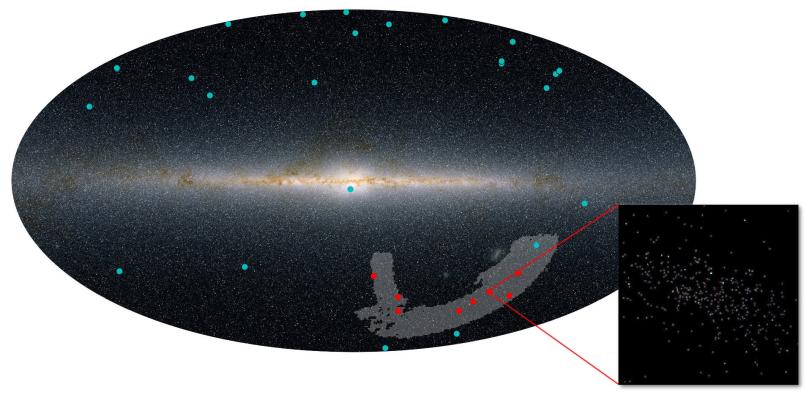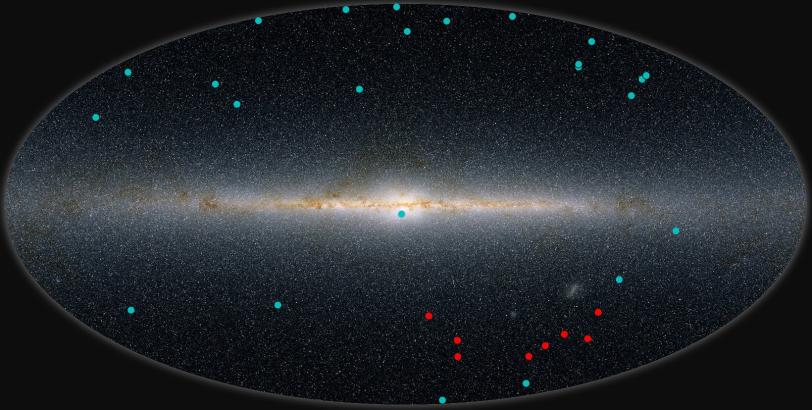Possible Rare Dwarf Galaxies Found Orbiting Milky Way
Findings May Provide New Clues About Hypothetical Dark Matter Particles
Researchers have discovered a set of eight celestial objects orbiting our home galaxy, the Milky Way, that appear to be rare dwarf satellite galaxies. Dwarf galaxies are the smallest known galaxy structures and may hold the key to understanding dark matter.
The discovery was made independently by scientists of the Dark Energy Survey (DES) – a collaboration that includes researchers from the Department of Energy’s SLAC National Accelerator Laboratory – and a research group from the University of Cambridge in the UK. The teams jointly announced their findings today.
"This result is particularly exciting because dwarf galaxies are one of the best places to look for dark matter," says DES researcher Risa Wechsler from SLAC and Stanford University's Kavli Institute for Particle Astrophysics and Cosmology (KIPAC), one of the DES study's co-authors. "Finding more of these galaxies will also help us test and refine our models of how dark matter impacts the evolution of the universe and the formation of galaxies."
SLAC researchers also played a key role in two additional studies, one by the Large Area Telescope (LAT) collaboration, and one performed jointly by the LAT and DES collaborations, which did not find any signs of dark matter particles either in previously known dwarf galaxies or in the newly found objects. These results, also announced today, will help constrain future searches for mysterious dark matter.

Discovery of Dwarf Galaxy Candidates
On an astronomical scale, dwarf galaxies are very small and therefore difficult to spot. The smallest ones contain only a few hundred stars, compared to the hundreds of billions of stars in the Milky Way. The newly discovered objects are a billion times dimmer than the Milky Way and a million times less massive. The closest of them is about 100,000 light-years away.
Scientists have seen more than two dozen of these satellite galaxies around the Milky Way. About half were discovered in 2005 and 2006 by the Sloan Digital Sky Survey, the predecessor of DES. However, almost none have been discovered in the past five years.
DES found the new objects in a different portion of the sky, in images taken by the world’s most powerful digital camera mounted on a telescope in Chile.
While more analysis is required to confirm any of the observed objects as dwarf satellite galaxies, the researchers note their size, low surface brightness and significant distance from the center of the Milky Way as evidence that they are excellent candidates.
The DES team identified the potential dwarf galaxies by adapting a method developed in large part by KIPAC's Eli Rykoff, one of the study's co-authors. "I wrote a program that finds galaxies in galaxy clusters by associating galaxies of the same color that are located in the same region of the sky," Rykoff says. "A few years ago, Risa pointed out that we could use the same technique to look for the association of stars in dwarf galaxies."
The study’s two lead authors, Alex Drlica-Wagner from Fermi National Accelerator Laboratory and Keith Bechtol from the University of Chicago, both former KIPAC graduate students, followed up on the idea and applied it to the DES analysis.
Dwarf Galaxies and Dark Matter Research
Newly discovered dwarf galaxies would also present scientists with more opportunities to look for signatures of dark matter, which accounts for about 85 percent of all matter in the universe but whose nature is unknown.
“We know that dwarf galaxies are dominated by unseen dark matter because they are much more massive than all their visible stars taken together,” says KIPAC’s Matthew Wood, who led the dark matter analysis of the LAT studies.
The LAT is the principal scientific instrument on NASA’s Fermi Gamma-ray Space Telescope spacecraft. SLAC assembled the LAT and runs its data processing center. Scientists use the LAT to search for gamma rays as potential indicators of dark matter particles annihilating each other in space. Since dwarf galaxies are rich in dark matter and do not host other gamma-ray sources, they are ideal objects for this search.
For the first of the two LAT papers, the researchers conducted the most comprehensive and most sensitive dark matter analysis of dwarf galaxies to date. They reported that they did not see any gamma rays coming from 15 previously known dwarf satellite galaxies – a result that limits the properties hypothetical dark matter particles can have.
In the second study, the researchers analyzed the region of the sky in which DES found the dwarf galaxy candidates. Again, no significant gamma-ray emission was detected. “If these objects are confirmed as dwarf galaxies, they will increase the sensitivity of our analysis and further probe the properties of dark matter particles,” says KIPAC’s Andrea Albert, who helped develop estimates of the objects’ dark matter content.
The discovery of eight potential dwarf galaxies resulted from an analysis of the first year of DES data alone. Scientists expect that the experiment will find up to 30 of these galaxies over its planned five years of observations. The more targets DES finds, the more clues it will give to researchers about mysterious dark matter.
Editor’s note: Parts of this news feature are based on a joint press release by Fermilab and the University of Cambridge, UK.
Citations: The DES Collaboration, arXiv:1503.02584, 9 March 2015; S. E. Koposov et al., arXiv:1503.02079, 6 March 2015; The Fermi-LAT Collaboration, arXiv:1503.02641, 9 March 2015; The Fermi-LAT and DES Collaborations, arXiv:1503.02632, 9 March 2015.
For questions or comments, contact the SLAC Office of Communications at communications@slac.stanford.edu.
SLAC is a multi-program laboratory exploring frontier questions in photon science, astrophysics, particle physics and accelerator research. Located in Menlo Park, Calif., SLAC is operated by Stanford University for the U.S. Department of Energy's Office of Science.
SLAC National Accelerator Laboratory is supported by the Office of Science of the U.S. Department of Energy. The Office of Science is the single largest supporter of basic research in the physical sciences in the United States, and is working to address some of the most pressing challenges of our time. For more information, please visit science.energy.gov.






